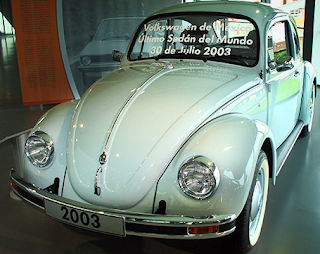 | The Volkswagen Beetle, officially the Volkswagen Type 1, is a two-door, four passenger, rear-engine economy car manufactured and marketed by German automaker Volkswagen from 1938 until 2003. |  |
 | The need for this kind of car was formulated by Adolf Hitler, leader of Nazi Germany, wishing for a cheap, simple car to be mass-produced for the new road network of his country. He contracted Porsche in 1934 to design and build it to his exacting standards. |  |
 |  |
 | The factory produced another wartime vehicle: the Kommandeurwagen; a Beetle body mounted on a 4WD Kübelwagen chassis. The Kommandeurwagen had widened fenders to accommodate it's Kronprinz all-terrain tires. Mass production of civilian VW cars did not start until post-war occupation. |  669 Kommandeurwagens were produced up to 1945. |
 Dr. Ferdinand Porsche | After World War II, the car was officially designated the Volkswagen Type 1, but was more commonly known as the Beetle. During the post-war period, the Beetle had superior performance in its category with a top speed of 115 km/h (71 mph) and 0–100 km/h (0–62 mph) in 27.5 seconds with fuel consumption of 6.7 l/100 km (36 mpg) for the standard 25 kW (34 hp) engine. In 1949 the car was exported to the US. On 17 February 1972, when Beetle No. 15,007,034 was produced, Beetle production surpassed the previous record holder, the Ford Model T. |  By 1973, total production was over 16 million, and by June 1992, over 21 million had been produced. |
 | Production in Brazil ended in 1986, then started again in 1993 and continued until 1996. The last Beetle was produced in Puebla, Mexico, in July 2003. The final batch of 3,000 Beetles were sold as 2004 models and badged as the Última Edición. |  VW 1303/Super Beetle (1973) |


No comments:
Post a Comment